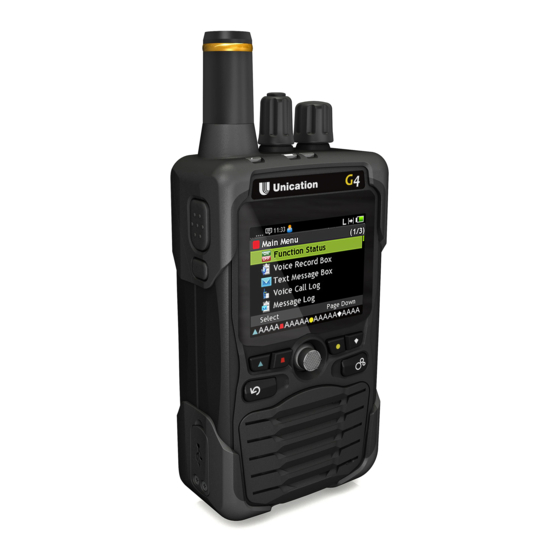Advertisement
Quick Links
Configuring the G4/5 For QCII over P25 Operation
1. Overview
QCII over P25 offers a number of advantages for implementing a paging solution on a P25 System.
They are:
• Minimizes use of TGIDs
• Minimal Dispatching process change
• Pager behavior closely matches that of the Minitor/G1 Analog pagers
• Works over Motorola ABME++ Capable RF
• Uses the identical QCII Tone set as Motorola
• Works with Wireless and IP connected Console environments
In the following sections a detailed review of QCII coding, Tone Sets and ways to configure the G4 or
G5 to support various behaviors are provided.
2. How Does QCII over P25 Work?
QCII over P25 uses a Talk Group ID (TGID) and it is over this TGID's assigned Talk Channel that the
QCII, 2-Tone, ID is sent. Many Dispatch Centers will patch analog VHF/UHF Channel traffic to a P25
TGID so Portable and Mobile users can hear these transmissions. In such applications adopting to
QCII over P25 paging should be straightforward.
There are differences between a standard analog 2-Tone frequency set and the set used for QCII
over P25 paging. Refer to Figures 1 and 2 on the following pages.
Figure 1 is an example of a Motorola analog 2-Tone set and one can see the tone frequencies are
defined and their spacing runs 3-6%.
In Figure 2, QCII over P25 defines frequency range of 31.25 to 62.5Hz for each of its 72 groups.
Any frequency that falls into a specific range is decoded the same. So, for example, if an analog
tone of 349Hz is patched to a P25 TGID, it will get decoded as Index 3. And, an analog tone of
330.5Hz will also get decoded as Index 3.
The significance of these differences and how one programs a G4/5 for QCII over P25 will be
explained in a later section.
Page 1
Advertisement

Summary of Contents for unication G4
- Page 1 • Uses the identical QCII Tone set as Motorola • Works with Wireless and IP connected Console environments In the following sections a detailed review of QCII coding, Tone Sets and ways to configure the G4 or G5 to support various behaviors are provided.
- Page 2 Figure 1: Page 2...
- Page 3 Figure 2: Page 3...
- Page 4 “patched” over P25 or if a new coding plan is to be developed. If the plan is for current analog 2-Tones to be used to page a G4/5 pager then as mentioned earlier, care must be taken in the assignments to ensure there is a “one to one” relationship.
- Page 5 A. Assigning the TGID(s) and the QCII over P25 Codes With the G4/5 Programming Software select Tab D.4 to assign the TGID(s) and the QCII over P25 Codes. Refer to Figure 4 below, where an example is provided. Refer to the bottom three rows where the P25 Sub-Group ID are set.
- Page 6 B. Setting the Zone and Channel Setting In Tab D.5 there are several new settings and a new Talk Group List. Figures 5-9 represent one Selector Knob setting and each new setting and the Talk Group List will be explained in detail. Figure 5: Figure 6: Page 6...
- Page 7 Figure 7: Figure 8: Page 7...
- Page 8 Call Alert paging “Call Alert Feature” is selected. 2. Reset Mode- If the Binding Feature is set for “Sub-Group Feature" there are five selections. a. Auto Reset- At the end of the page’s voice message the G4/5 goes back to Stand-By mode awaiting another QCII page.
- Page 9 Figure 11. Figure 10 5. Configuring the G4/5 for Different Behaviors Figure 11 provides different Use Case Scenarios and the associated settings. A. Scenario 1- is identical to the analog Selective Call operation. In this case the pager is mute until it detects a programmed QCII ID and stores the paging voice message.
- Page 10 TGIDs. NOTE: only consider programming multiple TGIDs if the System supports TGID Priority to ensure an incoming page is not missed. B. Scenarios 3 and 4 are special cases and may not apply to paging applications. Figure 11 Scenario Binding Feature Reset Mode TGIDs In Talk Group List TGIDS in Revert Talk Group List...
- Page 11 After the message is heard the pager will go mute awaiting any traffic on the TGID assigned the QCII IDs. Key programming settings to configure the G4/5 for Selective Call Mode are shown in Figures 1A-5A below. Below, several of the Key settings are reviewed.
- Page 12 Figure 1A Figure 2A Page 12...
- Page 13 Figure 3A Figure 4A Page 13...
- Page 14 TGID. If a valid QCII ID is decoded the pager will alert, play/store the message and revert back to listening all transmissions on the TGID. To configure the G4/5 for this behavior follow the same procedure for Selective Call Mode except in Figure 5A ENABLE the Alternative setting.















Need help?
Do you have a question about the G4 and is the answer not in the manual?
Questions and answers